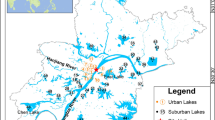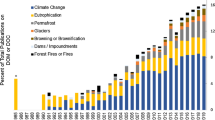Abstract
To evaluate the influence of human activities on ecosystem respiration (CO2) and CH4 fluxes and determine the seasonal and spatial variations, we measured CO2 and CH4 fluxes at four sampling sites (west side of the seawall, WSS; oilfield, OF; Spartina alterniflora coastal marsh, SCM; aquaculture pond, ACP) in the Yellow River estuary from June to December in 2013. Both CO2 and CH4 fluxes showed seasonal and spatial variations in the Yellow River estuary. The average CO2 fluxes from WSS, OF, SCM and ACP were 125.36, 111.03, 241.97 and −39.49 mg CO2 m−2 h−1, while CH4 fluxes were −0.0110, −0.0165, 0.2012 and 0.0034 mg CH4 m−2 h−1, respectively. Spatial variations of CO2 and CH4 fluxes were mainly affected by vegetation and soil moisture. There were significant relationships between both CO2 fluxes in WSS and SCM and CH4 flux in SCM with temperature. CO2 and CH4 fluxes were mainly affected by the interactions of thermal conditions and other abiotic factors in OF and ACP. Human activities have great effect on greenhouse gas emission, especially in the area where exotic-species S. alterniflora invaded. The construction of seawall blocked sea water transporting into the study area leading to low soil moisture which accelerated CO2 emission. Aquaculture ponds act as an emission of CH4 and consumption of CO2.



Similar content being viewed by others
References
Allen DE, Dalal RC, Rennenberg H, Meyer RL, Reeves S, Schmidt S (2007) Spatial and temporal variation of nitrous oxide and methane flux between subtropical mangrove sediments and the atmosphere. Soil Biology Biochemistry 39:622–631. doi:10.1016/j.soilbio.2006.09.013
An SQ, Gu BH, Zhou CF, Wang ZS, Deng ZF, Zhi YB, Li HL, Chen L, Yu DH, Liu YH (2007) Spartina invasion in China: implications for invasive species management and future research. Weed Research 47:183–191. doi:10.1111/j.1365- 3180.2007.00559.x
Bi XL, Liu FQ, Pan XB (2012) Coastal projects in China: from reclamation to restoration. Environmental Science Technology 46:4691–4692. doi:10.1021/es301286d
Chen GC, Tam NFY, Ye Y (2010) Summer fluxes of atmospheric greenhouse gases N2O, CH4 and CO2 from mangrove soil in South China. Science of Total Environment 408:2761–2767. doi:10.1016/j.scitotenv.2010.03.007
Chen J, Wang SY, Mao ZP (2011) Monitoring wetland changes in Yellow River delta by remote sensing during 1976–2008. Progress in Geography 30:585–592
Cheng XL, Peng RH, Chen JQ, Luo YQ, Zhang QF, An SQ, Chen JK, Li B (2007) CH4 and N2O emissions from Spartina alterniflora and Phragmites australis in experimental mesocosms. Chemosphere 68:420–427. doi:10.1016/j. chemosphere. 2007.01.00
Cheng XL, Luo YQ, Xu Q, Lin GH, Zhang QF, Chen JK, Li B (2010) Seasonal variation in CH4 emission and its 13C-isotopic signature from Spartina alterniflora and Scirpus mariqueter soils in an estuarine wetland. Plant and Soil 327:85–94. doi:10.1007/s11104-009-0033-y
Christensen TR (1993) Methane emission from Arctic tundra. Biogeochemistry 21:117–139. doi:10.1007/BF00000874
Christensen TR, Panikov N, Mastepanov M, Joabsson A, Stewart A, Öquist M, Sommerkorm M, Reynaud S, Svensson B (2003) Biotic controls on CO2 and CH4 exchange in wetlands–a closed environment study. Biogeochemistry 64:337–354. doi:10.1023/A:1024913730848
Cui BS, Yang QC, Yang ZF, Zhang KJ (2009) Evaluating the ecological performance of wetland restoration in the Yellow River delta, China. Ecological Engineering 35:1090–1103. doi:10.1016/j.ecoleng.2009.03.022
Del Giorgio PA, Cole JJ, Caraco NF, Peters RH (1999) Linking planktonic biomass and metabolism to net gas fluxes in northern temperate lakes. Ecology 80:1422–1431. doi:10.1890/0012-9658(1999) 080
Diem T, Koch S, Schwarzenbach S, Wehrli B, Schubert CJ (2012) Greenhouse gas emissions (CO2, CH4, and N2O) from several perialpine and alpine hydropower reservoirs by diffusion and loss in turbines. Aquatic Sciences 74:619–635. doi:10.1007/s00027-012-0256-5
Ding WX, Cai ZC, Tsuruta H (2004) Diel variation in methane emissions from the stands of Carex lasiocarpa and deyeuxia angustifolia in a cool temperate freshwater marsh. Atomospheric Environment 38:181–188. doi:10.1016/j. atmosenv. 2003. 09.066
Han N, Shao Q, Lu CM, Wang BS (2005) The leaf tonoplast V-H+-ATPase activity of a C3 halophyte Suaeda salsa is enhanced by salt stress in a Ca-dependent mode. Journal of Plant Physiology 162:267–274
Hirota M, Senga Y, Seike Y, Nohara S, Kunii H (2007) Fluxes of carbon dioxide, methane and nitrous oxide in two contrastive fringing zones of coastal lagoon, Lake Nakaumi, Japan. Chemosphere 68:597–603. doi:10.1016/j.chemosphere. 2007. 01.002
Huttunen JT, Alm J, Liikanen JS, Larmola T, Hannar T, Sivola J, Martikainen PJ (2003) Fluxes of methane, carbon dioxide and nitrous oxide in boreal lakes and potential anthropogenic effects on the aquatic greenhouse gas emissions. Chemosphere 52:609–621. doi:10.1016/S0045-6535(03)00243-1
Inubushi K, Furukawa Y, Hadi A, Purnomo E, Tsuruta H (2003) Seasonal changes of CO2, CH4 and N2O fluxes in relation to land-use change in tropical peatlands located in coastal area of South Kalimantan. Chemosphere 52:603–608. doi:10.1016/ S0045- 6535(03)00242-X
IPCC (2007) Climate change 2007: the scientific basis. Cambridge University Press, New York
Jiang C, Yu G, Fang H, Cao G, Li Y (2010) Short-term effect of increasing nitrogen deposition on CO2, CH4 and N2O fluxes in an alpine meadow on the Qinghai-Tibetan Plateau, China. Atmospheric Environment 44:2920–2926. doi:10.1016/j.atmosenv.2010.03.030
Jones DL, Hodge A, Kuzyakov Y (2004) Plant and mycorrhizal regulation of rhizodeposition. New Phytologist 163:459–480. doi:10.1111/j.1469-8137. 2004.01130.x
Kutzbach L, Wagner D, Pfeiffer EM (2004) Effect of microrelief and vegetation on methane emission from wet polygonal tundra, Lena Delta, Northern Siberia. Biogeochemistry 69:341–362. doi:10.1023/B:BIOG.0000031053.81520.db
Magenheimer JF, Moore TR, Chmura GL, Daoust RJ (1996) Methane and carbon dioxide flux from a macrotidal salt marsh, Bay of fundy, New Brunswick. Estuaries 19:139–145. doi:10.2307/1352658
Minoda T, Kimura M, Wada E (1996) Photosynthates as dominant source of CH4 and CO2 in soil water and CH4 emitted to the atmosphere from paddy fields. Journal of Geophysical Research 101:21091–21097. doi:10.1029/96JD01710
Nykänen H, Alm J, Silvola J, Tolonen K, Martikainen PJ (1998) Methane fluxes on boreal peatlands of different fertility and the effect of long-term experimental lowering of the water table on flux rates. Global Biogeochemical 12:53–69. doi:10.1029/97GB02732
Poffenbarger HJ, Needelman BA, Megonigal JP (2011) Salinity influence on methane emissions from tidal marshes. Wetlands 31:831–842. doi:10.1007/s13157-011-0197-0
Purvaja R, Ramesh R (2001) Natural and anthropogenic methane emission from coastal wetlands of south India. Environmental Management 27:547–557. doi:10.1007/s002670010169
Qin P, Zhong CX (1992) Applied studies on Spartina. Ocean Press, China. Rounsevell MDA, Reay DS (2009) Land use and climate change in UK. Land Use Policy 26: s160-s169. doi: 10.1016/j.landusepol.2009.09.007
Schrier-Uijl AP, Veraart AJ, Leffelaar PA, Berendse F, Veenendaal EM (2011) Release of CO2 and CH4 from lakes and drainage ditches in temperate wetlands. Biogeochemistry 102:265–279. doi:10.1007/s10533-010-9440-7
Silvennoinen H, Liikanen A, Rintala J, Martikainen PJ (2008) Greenhouse gas fluxes from the eutrophic Temmesjoki River and its Estuary in the Liminganlahti Bay (the Baltic Sea). Biogeochemistry 90:193–208. doi:10.1007/s10533-008-9244-1
Song CC, Zhang JB, Wang YY, Wang YS, Zhao ZC (2008) Emissions of CO2, CH4 and N2O from freshwater in northeast of China. Journal of Environmental Management 88:428–436. doi:10.1016/j.jenvman.2007.03.030
Song J, Chen M, Feng G, Jia YH, Wang BS, Zhang FS (2009) Effect of salinity on growth, ion accumulation and the roles of ions in osmotic adjustment of two populations of Suaeda salsa. Plant and Soil 314:133–141. doi:10.1007/s11104-008-9712-3
Søvik AK, Kløve B (2007) Emission of N2O and CH4 from a constructed wetland in southeastern Norway. Science of the Total Environment 380:28–37. doi:10.1016/j.scitotenv.2006.10.007
Striegl RG, Kortelainen P, Chanton JP, Wickland KP, Bugna GC, Rantakori M (2001) Carbon dioxide partial pressure and 13C content of north temperate and boreal lakes at spring ice melt. Limnology and Oceanography 46:941–945
Ström L, Mastepanov M, Christensen TR (2005) Species-specific effects of vascular plants on carbon turnover and methane emissions from wetlands. Biogeochemistry 75:65–82. doi:10.1007/s10533-004-6124-1
Sun ZG, Wang LL, Tian HQ, Jiang HH, Mou XJ, Sun WL (2013) Fluxes of nitrous oxide and methane in different coastal Suaeda salsa marshes of the Yellow River estuary, China. Chemosphere 90:856–865. doi:10.1016/j.chemosphere. 2012. 10.004
Sun ZG, Wang LL, Mou XJ, Jiang HH, Sun WL (2014) Spatial and temporal variations of nitrous oxide flux between coastal marsh and the atmosphere in the Yellow River estuary of China. Environmental Science and Pollution Research 21:419–433. doi:10.1007/s11356-013-1885-5
Teiter S, Mander Ü (2005) Emission of N2O, N2, CH4, and CO2 from constructed wetlands for wastewater treatment and from riparian buffer zones. Ecological Engineering 25:528–541. doi:10.1016/j.ecoleng.2005.07.011
Tong C, Wang WQ, Zeng CS, Marrs R (2010) Methane (CH4) emission from a tidal marsh in the Min River estuary, southeast China. Journal of Environmental Science and Health Part A 45:506–516
Tong C, Wang WQ, Huang JF, Gauci V, Zhang LH, Zeng CS (2012) Invasive alien plants increase CH4 emissions from a subtropical tidal estuarine wetland. Biogeochemistry 111:677–693. doi:10.1007/s10533-012-9712-5
Tremblay A, Therrien J, Hamlin B, Wichmann E, LeDrew LJ (2005) GHG emissions from boreal reservoirs and natural aquatic ecosystems. In greenhouse gas emissions-fluxes and processes. Springer, Berlin, pp 209–232
Van Bodegom PM, Scholten J (2001) Microbial processes of CH4 production in a rice paddy soil: model and experimental validation. Geochimica et Cosmochimica Acta 65:2055–2066. doi:10.1016/S0016-7037(01)00563-4
Van Der Nat FJ, Middelburg JJ (2000) Methane emission from tidal freshwater marshes. Biogeochemistry 49:103–121. doi:10.1023/A:1006333225100
Walker LR, Smith SD (1997) Impacts of invasive plants on community and ecosystem properties. In assessment and management of plant invasions. Springer, New York, pp 69–86
Wang FY, Liu RJ, Lin XG, Zhou JM (2004) Arbuscular mycorrhizal status of wild plants in saline-alkaline soils of the Yellow River delta. Mycorrhiza 14:133–137. doi:10.1007/s00572-003-0248-3
Wang Q, An SQ, Ma ZJ, Zhao B, Chen JK, Li B (2006a) Invasive Spartina alterniflora: biology, ecology and management. Acta Phytotaxonomica Sinica 44:559–588. doi:10.1360/aps06044
Wang Q, Wang CH, Zhao B, Ma ZJ, Luo YQ, Chen JK, Li B (2006b) Effects of growing conditions on the growth of and interactions between salt marsh plants: implications for invasibility of habitats. Biological Invasions 8:1547–1560. doi:10.1007/s10530-005-5846-x
Wang YH, Yang JM, Zhang ML, Song XJ, Wang WJ, Sun GH (2013) The study of biodiversity of micro-phytoplankton in sea cucumber aquaculture ponds of Yellow River delta. Qceanologia Et Limnologia Sinica 44:415–420
Watanabe A, Takeda T, Kimura M (1999) Evaluation of origins of CH4 carbon emitted from rice paddies. Journal of Geophysical Research: Atmospheres (1984–2012) 104:23623–23629. doi:10.1029/1999JD900467
Whalen SC (2005) Biogeochemistry of methane exchange between natural wetlands and the atmosphere. Environmental Engineering Science 22:73–94. doi:10.1089/ees.2005.22.73
Whiting GJ, Chanton JP (2001) Greenhouse carbon balance of wetlands: methane emission versus carbon sequestration. Tellus B 53:521–528. doi:10.1034/j.1600-0889.2001.530501.x
Xing YP, Xie P, Yang H, Ni LY, Wang YS, Rong KW (2005) Methane and carbon dioxide fluxes from a shallow hypereutrophic subtropical Lake in China. Atmospheric Environment 39:5532–5540. doi:10.1016/j.atmosenv.2005.06.010
Xu XG, Guo HH, Chen XL, Lin HP, Du QL (2002) A multi-scale study on land use and land cover quality change: the case of the Yellow River delta in China. GeoJournal 3:177–183. doi:10.1023/A:1025175409094
Yang P, Tong C, He QH, Huang JF (2012) Diurnal variations of greenhouse gas fluxes at the water-air interface of aquaculture ponds in the Min River estuary. Environmental Science 33:4194–4204
Zhang YH, Ding WX, Cai ZC, Valerie P, Han FX (2010) Response of methane emission to invasion of Spatina alterniflora and exogenous N deposition in the coastal salt marsh. Atmospheric Environment 44:488–4594. doi:10.1016/j. atmosenv. 2010.08.012
Zhang LH, Song LP, Zhang LW, Shao HB (2014) Diurnal dynamics of CH4, CO2 and N2O fluxes in the saline-alkaline soils of the Yellow River delta, China. Plant Biosystems-An International Journal Dealing with all Aspects of Plant Biology. doi:10.1080/11263504.2013.870937
Zhu SW, Pan XL, Li XQ, Liu C (2012) Effects of exotic Spartina anglica on ecological environment of the Yellow River delta. Shandong Agricultural Sciences 44(73–75):83
Acknowledgments
The authors would like to acknowledge the financial support of the National Basic Research Program of China, (No. 2013CB430401).
Author information
Authors and Affiliations
Corresponding author
Rights and permissions
About this article
Cite this article
Song, H., Liu, X. Anthropogenic Effects on Fluxes of Ecosystem Respiration and Methane in the Yellow River Estuary, China. Wetlands 36 (Suppl 1), 113–123 (2016). https://doi.org/10.1007/s13157-014-0587-1
Received:
Accepted:
Published:
Issue Date:
DOI: https://doi.org/10.1007/s13157-014-0587-1




